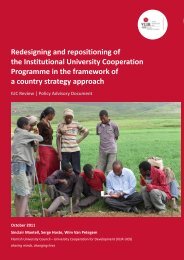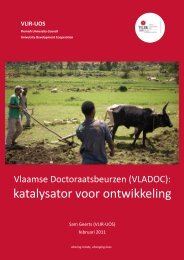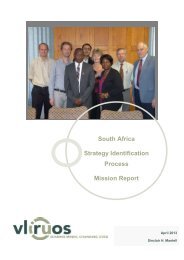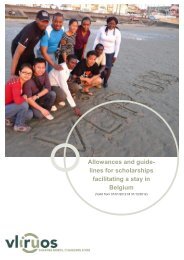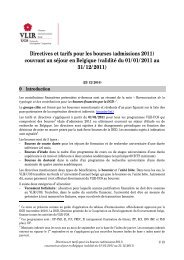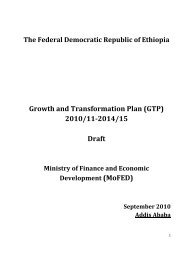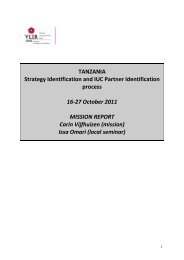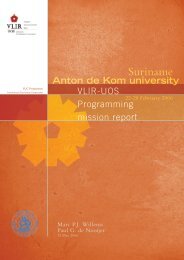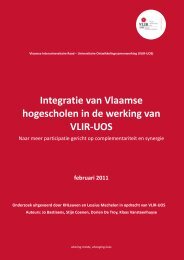Education Sector Development Program - VLIR-UOS
Education Sector Development Program - VLIR-UOS
Education Sector Development Program - VLIR-UOS
You also want an ePaper? Increase the reach of your titles
YUMPU automatically turns print PDFs into web optimized ePapers that Google loves.
<strong>Education</strong> <strong>Sector</strong> <strong>Development</strong> <strong>Program</strong> IV<br />
<strong>Education</strong> in Emergencies<br />
1. Situation analysis<br />
<strong>Education</strong> in situations of emergency and<br />
crisis is one of the “flagship” programs of the<br />
global ‘<strong>Education</strong> For All’ (EFA) campaign. It<br />
was recognized in the Dakar World <strong>Education</strong><br />
Forum (2000) that one of the barriers to attaining<br />
the EFA goals was the large population of children<br />
who are forced out of school due to conflict, wars,<br />
rapid and slow onset of disasters such as floods<br />
and droughts.<br />
<strong>Education</strong> in emergencies (EiE) was recognized<br />
as a key component of humanitarian response<br />
in Ethiopia when the National <strong>Education</strong> Cluster,<br />
including members from Ministry of <strong>Education</strong><br />
and International and national NGOs, was<br />
set up in October 2008. The cluster’s role is to<br />
support the Ministry of <strong>Education</strong> in ensuring<br />
that children continue to receive some form of<br />
education during emergencies and to develop a<br />
preparedness strategy for future emergencies.<br />
The cluster has been supporting the Regional<br />
<strong>Education</strong> Bureaus to manage and strengthen<br />
the regional task forces.<br />
Eight regions (Somali, Afar, Gambella, Amhara,<br />
Tigray, SNNPR, Benshangul Gumz and Oromiya)<br />
identified as emergency prone are affected every<br />
year by drought, floods and/or ethnic conflict.<br />
The recurrent nature of these emergencies along<br />
with pre-existing poverty and the complexities<br />
of pastoralist and agro-pastoralist communities<br />
affect thousands of children every year. The<br />
ability of children to access education is severely<br />
compromised as children drop out of school due<br />
to poverty, schools remain closed for extended<br />
periods of time, teachers leave the affected<br />
areas, school buildings are used as shelters or<br />
are damaged, school materials are damaged,<br />
children and their families are displaced from<br />
their villages and live in temporary shelters for<br />
long periods.<br />
The unavailability of comprehensive information<br />
on the impact of emergencies on drop out,<br />
enrolment rates and overall education status<br />
leads to inadequate and untimely response.<br />
Consequently, thousands of children who drop<br />
out during an emergency continue to remain out<br />
of school affecting the drop out of school age<br />
children as a result of displacement or migration.<br />
According to the seasonal assessment reports<br />
conducted by the national and regional task<br />
forces organized to identify hot spots and to<br />
enable the Government, donors, international<br />
and local NGOs and the local community to act,<br />
there is the likelihood that these emergencies<br />
might continue to occur in the near future and as<br />
a result they must be mainstreamed in ESDP IV.<br />
Main challenges<br />
• Enrolment rates remain low and<br />
drop-out rates remain high in<br />
emergency-affected areas.<br />
• Lack of awareness of the impact<br />
of emergencies on education and<br />
therefore inadequate response<br />
by the education sector to<br />
emergency situations.<br />
• Lack of commitment from sector<br />
actors, and lack of budget to<br />
respond to emergency situations<br />
• Lack of co-ordination at Regional<br />
Level<br />
2. Expected program outcomes<br />
Awareness on education in emergencies<br />
developed through teacher education<br />
Children affected by emergencies will<br />
continue their schooling<br />
Capacity of administrators, communities<br />
and schools to manage education in<br />
emergencies made stronger<br />
Information on emergency situations<br />
included in <strong>Education</strong> Management<br />
Information System<br />
<strong>Education</strong> management systems built<br />
to plan and prepare for education<br />
response in an emergency<br />
Key outcome targets<br />
All teachers who work in emergency<br />
context will be able to deliver education<br />
in emergencies<br />
All woreda offices based in emergency<br />
contexts will have participated in capacity<br />
development programs and be able to<br />
implement EiE programs<br />
Collection of EiE data to be strengthened<br />
and mainstreamed into other data collection<br />
exercises carried out within the sector.<br />
Each affected region will have an emergency<br />
preparedness response plan and a task force to<br />
implement and monitor the plan.<br />
Thousands of<br />
children who drop<br />
out during an emergency<br />
continue to remain out of<br />
school affecting the drop<br />
out of school age children<br />
as a result of displacement<br />
or migration.<br />
83




